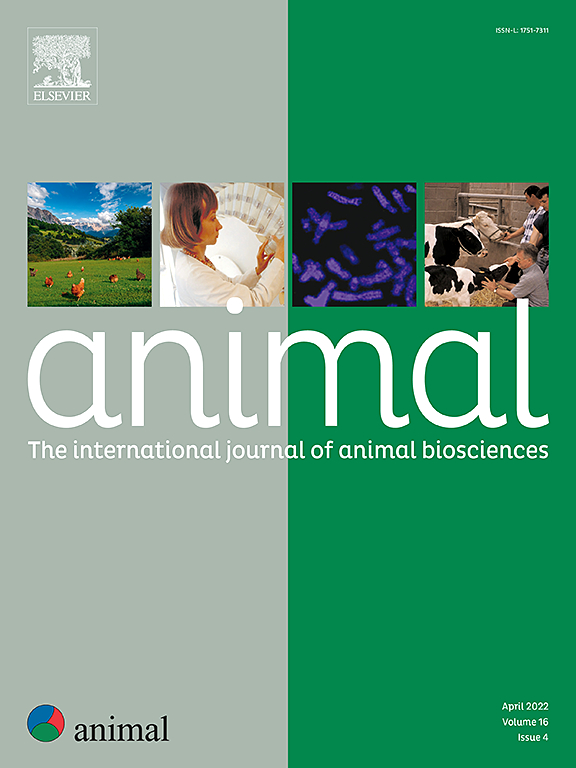对玛蒂娜·弗兰卡驴品种系谱和基因组近交模式的见解
IF 4.2
2区 农林科学
Q1 AGRICULTURE, DAIRY & ANIMAL SCIENCE
引用次数: 0
摘要
保护小型、濒危的马种群需要工具来更准确地捕捉最近和历史上的近亲繁殖,而不仅仅是血统。玛蒂娜·弗兰卡驴是意大利南部的一个大型本土品种,在20世纪80年代濒临灭绝,它为马科动物的保护遗传学提供了一个相关的模型。在这里,我们结合了谱系和基于基因组的方法来量化近亲繁殖,通过纯合子(ROH)的运行来解开其时间成分,并突出假定的选择目标,以告知管理层。我们选取了101只登记在研究簿上的动物(70只雌性,31只雄性),并通过双酶切限制性位点相关DNA测序产生了全基因组数据,过滤后保留了21 280个高质量的单核苷酸多态性。我们估计了谱系近交(FPED1)和基于过度纯合(FHET, FHAT1-3)和roh衍生的基因组近交(FROH)的基因组指数。FPED1的范围为0.029 ~ 0.245(平均0.114),而FROH的范围为0.006 ~ 0.316(平均0.147),家系和基因组指标之间的一致性较弱,与不完整家系或创始人效应一致。在个体中,我们检测到4 433个ROH片段;中长片段(4-16 Mb)占主导地位,表明大量的近交,而非常短的ROH (< 2 Mb)很少见(约2%),表明古代自合子有限。ROH在基因组中的分布不均匀:2号和3号染色体的片段最多,而18号染色体的片段最少。我们在染色体2、6、8、12、13和19上发现了ROH岛;其中的候选基因包括SHH(发育)、EPAS1(缺氧反应)、OPRK1(应激反应)和BIRC5(细胞凋亡/细胞周期),指出了发育、恢复和繁殖的历史压力。总的来说,基因组测量——尤其是froi——提供了比单独的系谱更精细的自合子画像,并揭示了可能由选择形成的焦点区域。这些结果为寻求在保持适应性变异的同时限制进一步近亲繁殖的育种计划提供了可操作的指导,并说明了基因组监测如何能够加强全球濒危驴品种和其他小型马科动物种群的保护策略。本文章由计算机程序翻译,如有差异,请以英文原文为准。
Insights into pedigree- and genome-based inbreeding patterns in Martina Franca donkey breed
Conserving small, endangered equine populations demands tools that capture both recent and historical inbreeding more accurately than pedigree alone. The Martina Franca donkey, a large indigenous breed from southern Italy that approached extinction in the 1980s, offers a relevant model for conservation genetics in equids. Here, we combine pedigree- and genome-based approaches to quantify inbreeding, disentangle its temporal components via runs of homozygosity (ROH), and highlight putative selection targets to inform management. We sampled 101 studbook-registered animals (70 females, 31 males) and generated genome-wide data by the double-digest restriction-site associated DNA sequencing, retaining 21 280 high-quality Single Nucleotide Polymorphisms after filtering. We estimated pedigree inbreeding (FPED1) and genomic indices based on excess homozygosity (FHET, FHAT1–3) and ROH-derived genomic inbreeding (FROH). FPED1 ranged from 0.029 to 0.245 (mean 0.114), whereas FROH ranged from 0.006 to 0.316 (mean 0.147), with weak concordance between pedigree and genomic metrics, consistent with incomplete pedigrees or founder effects. Across individuals, we detected 4 433 ROH segments; medium-to-long segments (4–16 Mb) predominated, indicating substantial recent inbreeding, while very short ROH (< 2 Mb) were rare (about 2%), suggesting limited ancient autozygosity. ROH were unevenly distributed across the genome: chromosomes 2 and 3 harboured the most segments, whereas chromosome 18 had the fewest. We identified ROH islands on chromosomes 2, 6, 8, 12, 13, and 19; candidate genes therein included SHH (development), EPAS1 (hypoxia response), OPRK1 (stress response), and BIRC5 (apoptosis/cell cycle), pointing to historical pressures on development, resilience, and reproduction. Overall, genomic measures—particularly FROH—provided a finer-grained portrait of autozygosity than pedigree alone and revealed focal regions likely shaped by selection. These results deliver actionable guidance for breeding schemes seeking to limit further inbreeding while preserving adaptive variation, and they illustrate how genomic surveillance can bolster conservation strategies for endangered donkey breeds and other small equid populations worldwide.
求助全文
通过发布文献求助,成功后即可免费获取论文全文。
去求助
来源期刊

Animal
农林科学-奶制品与动物科学
CiteScore
7.50
自引率
2.80%
发文量
246
审稿时长
3 months
期刊介绍:
Editorial board
animal attracts the best research in animal biology and animal systems from across the spectrum of the agricultural, biomedical, and environmental sciences. It is the central element in an exciting collaboration between the British Society of Animal Science (BSAS), Institut National de la Recherche Agronomique (INRA) and the European Federation of Animal Science (EAAP) and represents a merging of three scientific journals: Animal Science; Animal Research; Reproduction, Nutrition, Development. animal publishes original cutting-edge research, ''hot'' topics and horizon-scanning reviews on animal-related aspects of the life sciences at the molecular, cellular, organ, whole animal and production system levels. The main subject areas include: breeding and genetics; nutrition; physiology and functional biology of systems; behaviour, health and welfare; farming systems, environmental impact and climate change; product quality, human health and well-being. Animal models and papers dealing with the integration of research between these topics and their impact on the environment and people are particularly welcome.
 求助内容:
求助内容: 应助结果提醒方式:
应助结果提醒方式:


